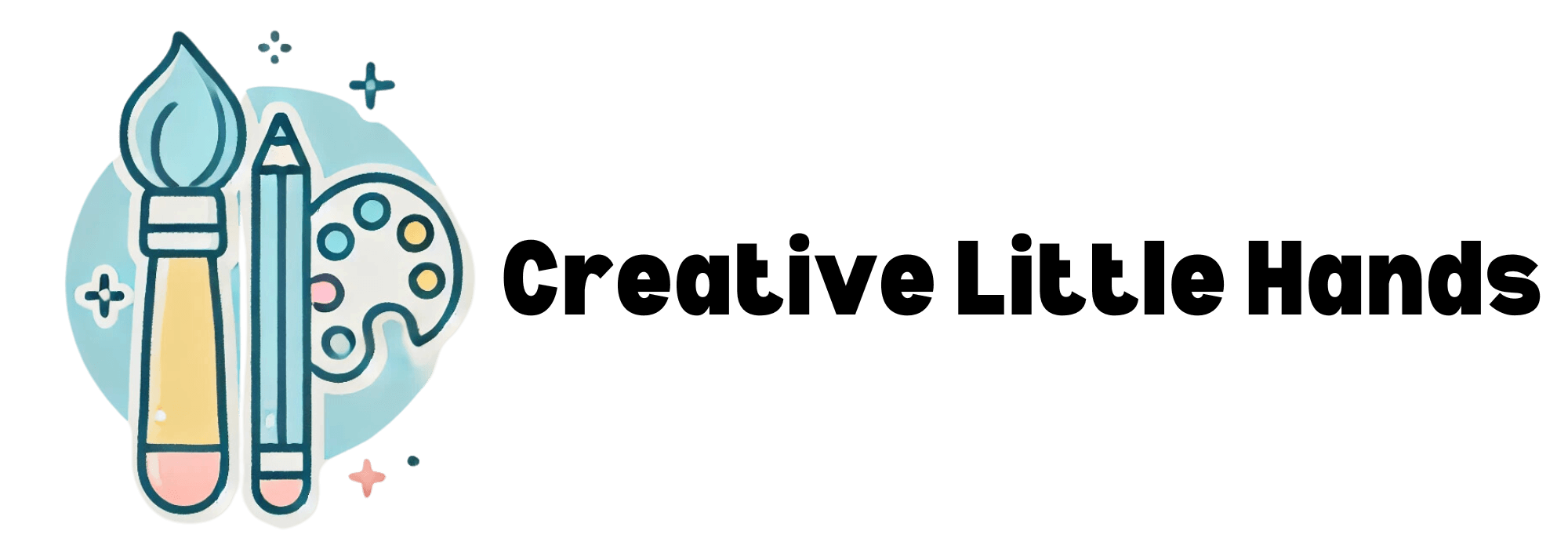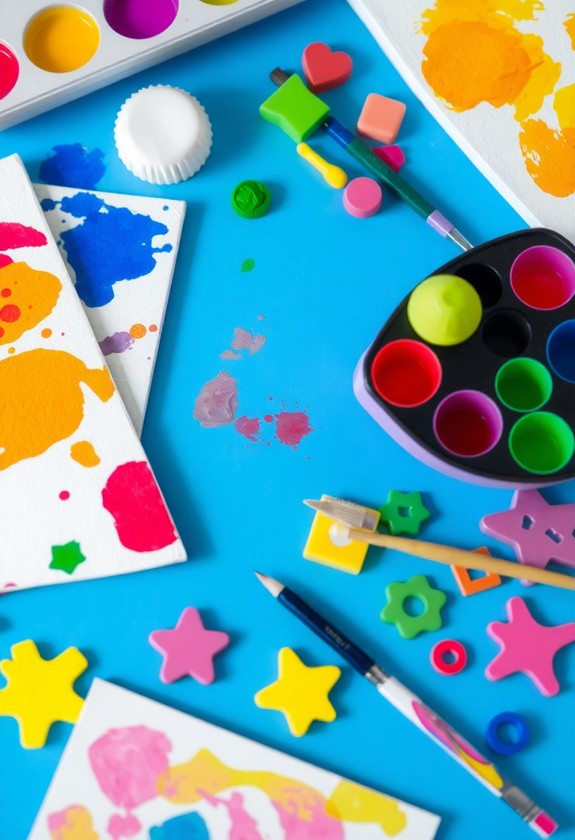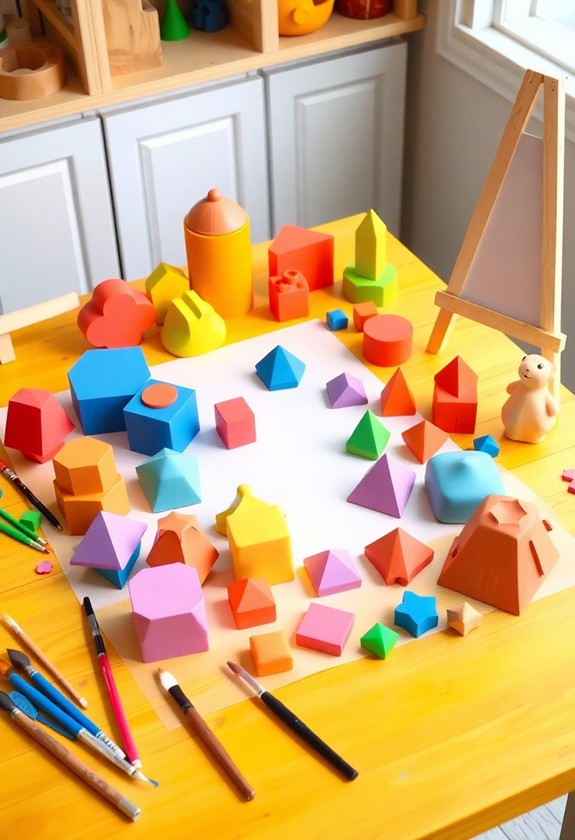Boost your toddler's brain power with these exciting artistic activities! Start with finger painting to stimulate their senses and teach color mixing. Move on to playdough sculpting for hands-on creativity and fine motor skill development. Create colorful collages to improve decision-making and hand-eye coordination. Investigate the world of sound with musical instrument making and playing. Finally, encourage storytelling through drawing to spark imagination and language skills. These fun-filled activities will engage your little one's mind and body, nurturing creativity and cognitive growth. But wait, there's so much more to uncover about each activity's amazing benefits!
Creative Highlights
- Finger painting stimulates sensory exploration and develops fine motor skills while fostering creativity and self-expression.
- Playdough sculpting promotes cognitive development, enhances problem-solving abilities, and strengthens hand-eye coordination.
- Collage making encourages decision-making, improves fine motor skills, and fosters artistic confidence through material exploration.
- Musical exploration boosts brain power, aids memory retention, and introduces concepts of sound dynamics through creative play.
- Storytelling through drawing enhances language skills, develops fine motor abilities, and encourages imaginative thinking via visual art.
Finger Painting Adventures

Four key benefits make finger painting an excellent artistic activity for toddlers' brain development. First, it's a sensory explosion! The squishy paint between their fingers stimulates their sense of touch. Second, it's a color bonanza that helps them learn about mixing and blending. Third, it's a creativity booster, letting their imagination run wild on paper. And fourth, it's a fine motor skill workout for those little hands! Finger painting additionally enhances self-expression through various art forms, cultivating confidence as toddlers create and showcase their unique artwork.
Getting Started:
You'll need washable finger paints, large paper, and a mess-friendly space. Lay out the supplies and let the fun begin! Encourage your toddler to investigate the paints with their hands. They might be hesitant at first, but soon they'll be finger-painting pros!
Fun Ideas:
- Make handprint animals – turn those messy prints into cute critters!
- Create a finger-paint family portrait – hilarious and heartwarming!
- Paint to music – let them express what they hear!
Playdough Sculpting Sessions
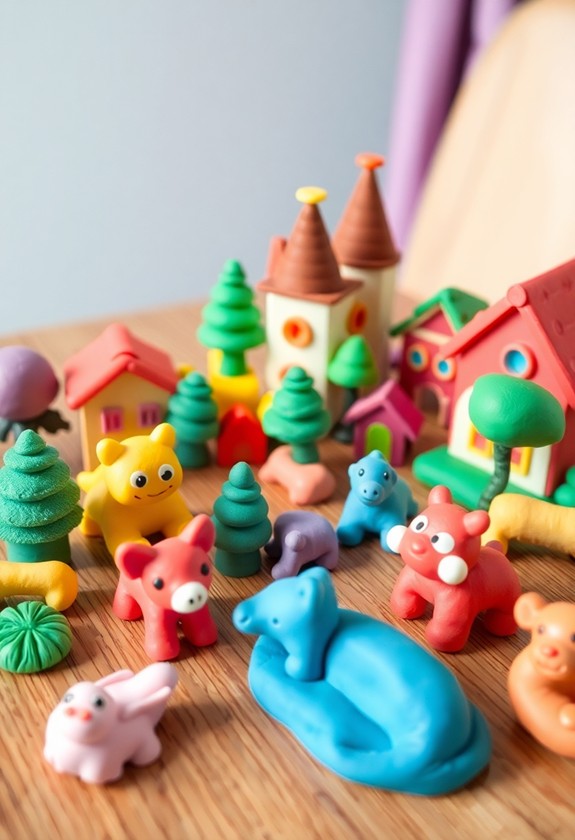
As finger painting offers a messy, colorful experience, playdough sculpting provides a different tactile adventure for toddlers. It's time to get your hands on some squishy, moldable fun! Arts and Crafts Supplies can improve this activity, offering a wide variety of tools and accessories to expand creativity. This type of craft additionally promotes cognitive and physical development as it encourages screen-free entertainment.
Start by gathering your supplies: colorful playdough, rolling pins, cookie cutters, and plastic knives. Now, let's plunge into it! Encourage your little one to squish, roll, and mold the dough. Watch as their tiny fingers knead and shape the pliable material. It's like a mini workout for their hands!
Try these exciting activities:
- Make a "playdough pizza" with toppings
- Create a zoo of animals
- Build a castle with towers and flags
As your toddler sculpts, they're developing fine motor skills and hand-eye coordination. But wait, there's more! They're additionally boosting creativity and problem-solving abilities. It's a win-win situation!
Don't forget to join in the fun! Show them how to mix colors or create simple shapes. And remember, it's okay if their creations look a bit, well, abstract. The process is what matters most!
Colorful Collage Making
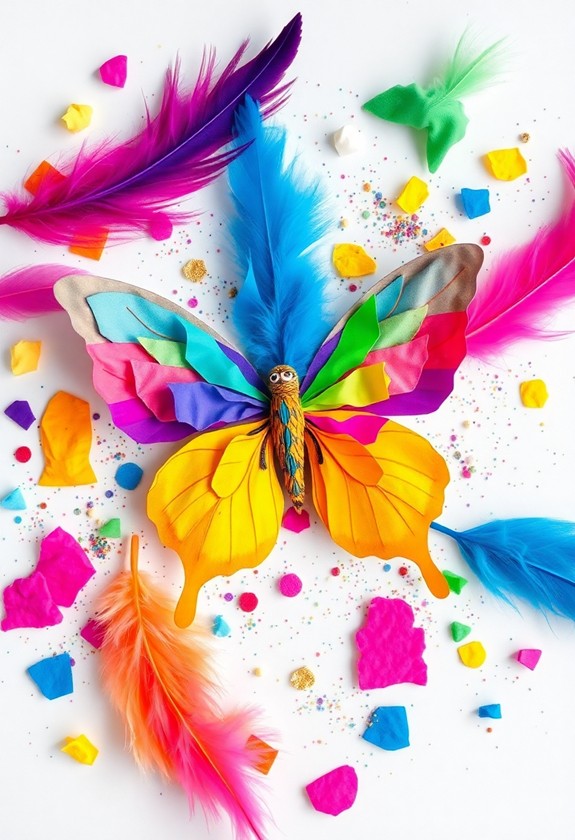
Scissors and glue at the ready! It's time to plunge into the colorful world of collage making with your toddler. This exciting activity isn't just fun—it's a brain-boosting bonanza! Your little one will love investigating textures, shapes, and colors as they develop fine motor skills and creativity. For a mess-free alternative, consider using sticker-based collage kits that promote creativity without the need for glue or paint.
Here's why collage making is a must-try:
- It encourages decision-making and problem-solving
- It boosts hand-eye coordination and dexterity
- It promotes self-expression and artistic confidence
To get started, gather a variety of materials: magazine cutouts, fabric scraps, feathers, and more. The sky's the limit! Spread everything out on a large surface and let your child's imagination run wild. They'll be gluing up a storm in no time!
Safety first: Always supervise your toddler when using scissors. Opt for child-safe scissors or pre-cut materials for younger children.
As your little Picasso creates their masterpiece, chat about the colors, shapes, and textures they're using. This verbal interaction helps develop language skills and reinforces concepts. And don't forget to display their artwork proudly—it's bound to be a stick-tacular addition to your fridge gallery!
Musical Instrument Exploration
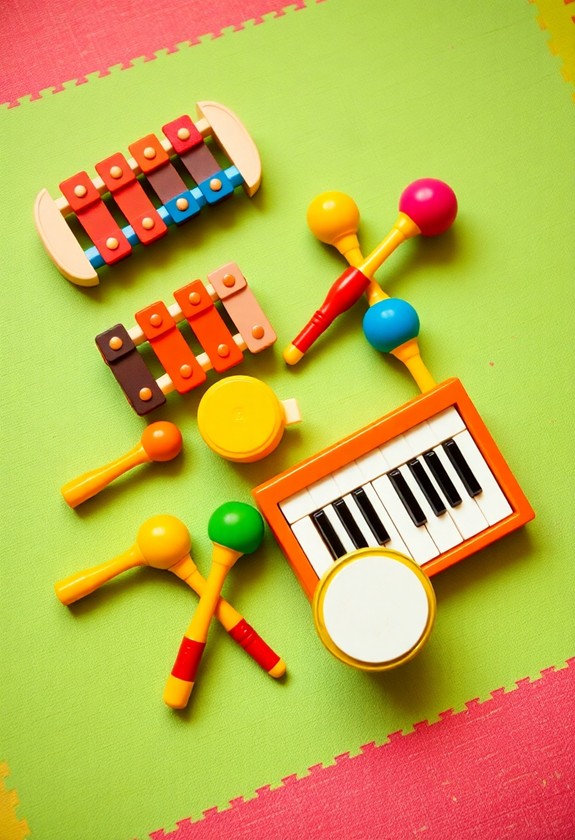
Get ready to make some noise with musical instrument investigation! This activity is a fantastic way to boost your toddler's brain power during having a blast. Multi-sensory experiences like this aid in memory retention and information processing, essential for early childhood development. You don't need fancy instruments – household items work wonders! Grab pots, pans, wooden spoons, and plastic containers to create a DIY drum set. Shake things up with homemade maracas using empty water bottles filled with beans or rice.
Let your little maestro investigate different sounds and rhythms. Encourage them to tap, shake, and bang away! This musical adventure helps develop fine motor skills, hand-eye coordination, and rhythm awareness. Plus, it's a great way to introduce basic concepts like loud and soft, fast and slow.
Try these fun ideas:
- Create a "sound scavenger hunt" around the house
- Make a cardboard guitar with rubber bands for strings
- Use an empty tissue box and rubber bands for a mini harp
Storytelling Through Drawing
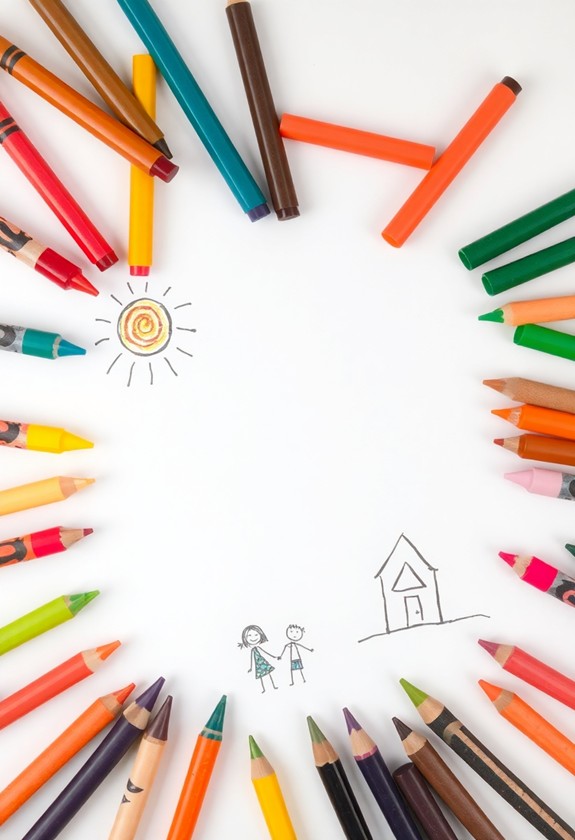
From musical exploration, let's turn our attention to visual storytelling. Storytelling through drawing is a fantastic way to boost your toddler's creativity and language skills! It's like opening a magical door to their imagination. Grab some crayons, markers, or finger paints, and watch as your little one's ideas come to life on paper! Eco-friendly craft options can as well be incorporated, using recycled materials to promote environmental awareness during crafting.
Here are three exciting ways to encourage storytelling through drawing:
- Ask open-ended questions: "What's happening in your picture?" or "Who's that funny character?"
- Create a story together: Take turns adding elements to the drawing and building a narrative.
- Use prompts: Suggest themes like "a day at the beach" or "visiting outer space" to spark ideas.
As your child draws, they're developing fine motor skills and hand-eye coordination. But that's not all! They're likewise learning to express themselves, organize thoughts, and communicate ideas. It's a brain-boosting bonanza!
Don't worry if the drawings look like scribbles at first. The magic is in the process, not the result. Encourage your little Picasso and watch their storytelling skills blossom!
Curious Little Questions
How Do Artistic Activities Impact Language Development in Toddlers?
You'll be amazed at how artistic activities enhance your toddler's language skills! When they paint, draw, or craft, they're not just having fun – they're building vocabulary! They'll learn colors, shapes, and textures as they describe their masterpieces. Singing songs and rhymes boosts their phonological awareness, too. And don't forget storytelling through art! As they explain their creations, they're practicing narrative skills. It's a creative language explosion that'll have your little one chattering away in no time!
Are There Any Safety Concerns When Introducing Art Materials to Toddlers?
Safety's a big deal regarding little artists. You'll want to keep a close eye on your toddler's artistic adventures. Watch out for choking hazards like small beads or buttons. Ensure paints and markers are non-toxic and washable. Scissors? Yikes! Stick to safety scissors under supervision. And don't forget, some kiddos might try to taste their masterpieces! Keep materials out of reach when not in use. With these precautions, your tiny Picasso can create safely and happily!
What Age Is Appropriate to Start Artistic Activities With Toddlers?
You can start artistic activities with your toddler as early as 12 months old! At this age, they're ready to investigate and create. But don't worry if you haven't started yet – it's never too late! By 18 months, most toddlers can grasp crayons and make marks. As they grow, their skills will blossom. Remember, it's all about fun and investigation, not perfection. So grab those chunky crayons and let the creativity flow! Your little Picasso is waiting to emerge!
How Can Parents Encourage Creativity Without Being Too Directive?
Get ready to release a tsunami of creativity with your little one! You can encourage their artistic side without being bossy. First, set up an art station with loads of supplies. Let them investigate freely! Ask open-ended questions like, "What does that shape remind you of?" Praise their efforts, not just results. Join in the fun, but don't take over. Remember, it's about the process, not perfection. And hey, a little mess is just part of the masterpiece!
Can Artistic Activities Help With Emotional Regulation in Toddlers?
Artistic activities can be a game-changer for your toddler's emotional regulation. When they're painting, drawing, or sculpting, they're not just creating masterpieces – they're learning to express themselves! It's like a magical mood-booster. These activities help your little one identify and process feelings, reduce stress, and build confidence. Plus, it's a fun way to practice focus and patience. So, grab those crayons and watch your tot's emotions become a work of art!
